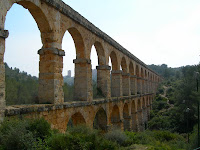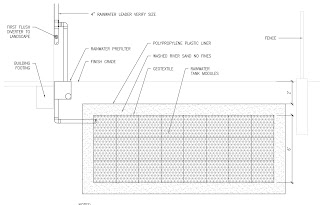There is a vast arena of jobs that
people do in the world, and frequently no one really knows what another person
does when they go to work. Most everyone has a title associated with their job,
but these titles generally do little to describe what a person actually does.
I don’t know what my family or
friends do at work, but every day they get up in the morning, go to work, and
come home in the evening. When I ask the question “What do you do all day at
work?” the answer is frequently “lots of things.”
As an architect, my answer to that
same question could also be “lots of things”.
Architecture is a design profession,
but the notion of design goes far beyond lines on paper (or computer monitor).
There is a great deal of variation within the field architecture, as there is
in most professions. Below is a look into what I do as a sole practitioner
architect, working in the San Francisco Bay Area. I have omitted the ‘behind
the scenes’ work, such as the work of landing a job, developing a program, discussing
and evaluating a budget, and many other associated processes that occur before a
project is actively begun.
Due diligence plays an integral role
in an architect’s job, although certainly this is not the sexy part of the
work. Due diligence includes: local code research; site-specific research;
understanding possible site restrictions; and procuring any documents required
by the governing agency such as a survey, soils report, etc. Feasibility
studies, programming, and budget analysis can also be part of this process.
Requirements such as design review, presenting to committees, height and
set-back limitations, and discussions and meetings with the governing
jurisdiction are also a part of due diligence.
Once the due diligence is underway
(and this can be an on-going process), the design can begin. Design is
typically broken into three parts: site design, schematic design, and design
development. But design is not a linear process with a beginning, middle, and
end. It is more of a serpentine movement, one that has a beginning and an end,
but with many wiggles in between.
It is nearly impossible to describe
a design process, as it is truly a process that begins with a line on a piece
of paper that is transformed, based on the site, geography, position of the
sun, clients’ needs and desires, program, and what is seen, heard, thought,
read, dreamed, smelled, and even eaten. The end product is both an abstract and
a dialogue that covers all elements of life, and it is dedicated to the client
and to good design.
There are sub-sets of design that
are more tangible and easier to describe than the pure design process. Site design is an important first
step in the design process, where geography, climate, solar evaluation, wind
and weather patterns, access, views, light quality, etc., are all important
factors to consider and understand before beginning the design of a building.
Other sub-sets of design which are part of an architect’s work include lighting
design (when a lighting consultant is not used), kitchen and bath design,
cabinet and furniture design, color, texture, and material palettes, furniture
lay-out, office lay-out, stair design, steel design, glass design, even textile
design.
As the design and details are being
developed, the architect's language is expressed graphically in the conventions
of plan, section, and elevation. Plans are views looking directly down at a
horizontal surface (a bird's eye view), and include floor plans, roof plan,
(showing all roof planes, roof slopes, skylights, and any other roof elements),
and electric plan (all light fixtures, receptacles, and light switching).
The floor plan shows location of all
walls, windows, doors, stairs, kitchen and bath lay-out, casework, decks and
patios, trellises, landscaping features, etc. Dimensions of all
exterior and interior walls and components are notated, as well as special instructions. Every
window and door is located within a wall and given a number, which is cross-referenced on the window/door
schedule (schedules discussed below). Architectural symbols are marked on the
plan denoting where sections, details, interior elevations, and blown-up plans
(frequently kitchens, baths, and special conditions) have been drawn. The plan becomes very dense
with information, and it is a bit of a design exercise to make this sheet easy
to read and also look graphically beautiful.
 |
| PLUShouse floor plan |
 Sections
are vertical cuts taken through a building, like cutting a loaf of bread into
slices. Several sections are frequently taken through a building in order to
describe different roof planes, floor elevation changes, wall conditions, etc.
Vertical control is identified on the sections, ceiling and roof heights
are dimensioned, stairs and railings are layed out and dimensioned, and any
other elements best described in sectional view are noted.
Sections
are vertical cuts taken through a building, like cutting a loaf of bread into
slices. Several sections are frequently taken through a building in order to
describe different roof planes, floor elevation changes, wall conditions, etc.
Vertical control is identified on the sections, ceiling and roof heights
are dimensioned, stairs and railings are layed out and dimensioned, and any
other elements best described in sectional view are noted. |
| PLUShouse sections |
Elevations
are views looking straight at a vertical plane, and are drawn for every
exterior wall and frequently for every interior wall. Elevations show windows,
doors, roofs, rain water downspouts, and any other elements located on a wall.
 |
| PLUShouse north & east elevations |
 |
| Fisher/Castellano stair details |
 |
| Mies van der Rohe |
As Mies van der Rohe (a German architect
at the forefront of modernist design in the
early 20th century) stated, “God is in the details.”
An empirical task architects perform is the development of product and material schedules. This is typically done in spread-sheet format. All products associated with the project - windows, doors, electric and plumbing products, hardware, appliances, etc. need to be listed and described by type, manufacturer, product identification number, size and color, as well as any special notations (e.g. window gets installed directly to corner post, no return). A finish schedule lays out similar information, and describes all materials and surface treatments used in the building, both interior and exterior. The finish schedule includes wall finishes, paint colors, flooring, kitchen countertop, casework, roofing, soffit, railings, decks and patio material etc. For instance, an interior stair rail will be specified as 3"x1/2" cold steel bar, clear finish, eased edges, blind weld spots. The schedules are ultimately used by the builder in pricing the building, ordering the materials and products, and getting the project built with the intended products and finishes.
 |
| Door schedule |
 |
| Structural/Architecture coordination |
An architect’s work does not end
once the design and construction documents are finalized, and the construction
has commenced. Architects are frequently involved in the selection of the
General Contractor (this frequently occurs at the project outset), the bidding and price negotiation process, and with budget
analysis and review. Other ‘behind the scenes’ tasks include client meetings,
presentations, model building, 3-dimensional drawings and sketches, sun angle
calculations (to determine the depth of roof overhangs or sun shades), product
research, permit submittals, keeping up with sustainable issues and products,
building and coordinating a strong project team, and so on.
  |
| Fisher/Castellano Residence |
It’s a lot of things, and it’s all about taking it from here to there.
Lindy Small Architecture AIA
www.LindySmallArchitecture.com
http://plushouse.blogspot.com
www.LindySmallArchitecture.com
http://plushouse.blogspot.com
Lindy@LindySmallArchitecture.com





















